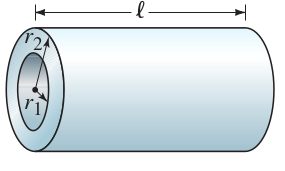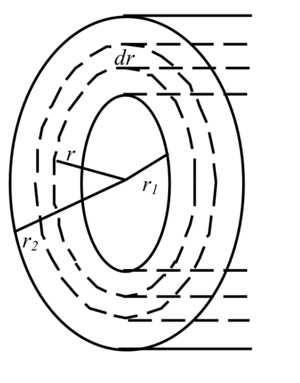Difference between revisions of "Chapter 25 Problem 30"
(Created page with "==Problem== thumb|right|The resistor A hollow cylindrical resistor with inner radius <math>r_1</math> and outer radius <math>r_2</math> , and...") |
|||
| Line 10: | Line 10: | ||
(b) Evaluate the resistance <math>R</math> for such a resistor made of carbon whose inner and outer radii are 1.0 mm and 1.8 mm and whose length is 2.4 cm | (b) Evaluate the resistance <math>R</math> for such a resistor made of carbon whose inner and outer radii are 1.0 mm and 1.8 mm and whose length is 2.4 cm | ||
| + | |||
| + | (c) What is the resistance in part (b) for current flowing parallel to the axis? | ||
| + | |||
==Solution== | ==Solution== | ||
[[File:Chapter25problem30s.png|300px|center|The resistor in pieces]] | [[File:Chapter25problem30s.png|300px|center|The resistor in pieces]] | ||
Revision as of 03:46, 25 March 2019
Problem
A hollow cylindrical resistor with inner radius and outer radius , and length , is made of a material whose resistivity is
(a) Show that the resistance is given by
for current that flows radially outward. [Hint: Divide the resistor into concentric cylindrical shells and integrate.]
(b) Evaluate the resistance for such a resistor made of carbon whose inner and outer radii are 1.0 mm and 1.8 mm and whose length is 2.4 cm
(c) What is the resistance in part (b) for current flowing parallel to the axis?
Solution
(a)
Failed to parse (Conversion error. Server ("https://wikimedia.org/api/rest_") reported: "Cannot get mml. TeX parse error: Double subscripts: use braces to clarify"): {\displaystyle R=\int dR=\int _{r}_{1}^{r}_{2}\rho {\frac {dr}{2\pi rl}}={\frac {\rho }{2\pi l}}\ln {\frac {r_{2}}{r_{1}}}}








